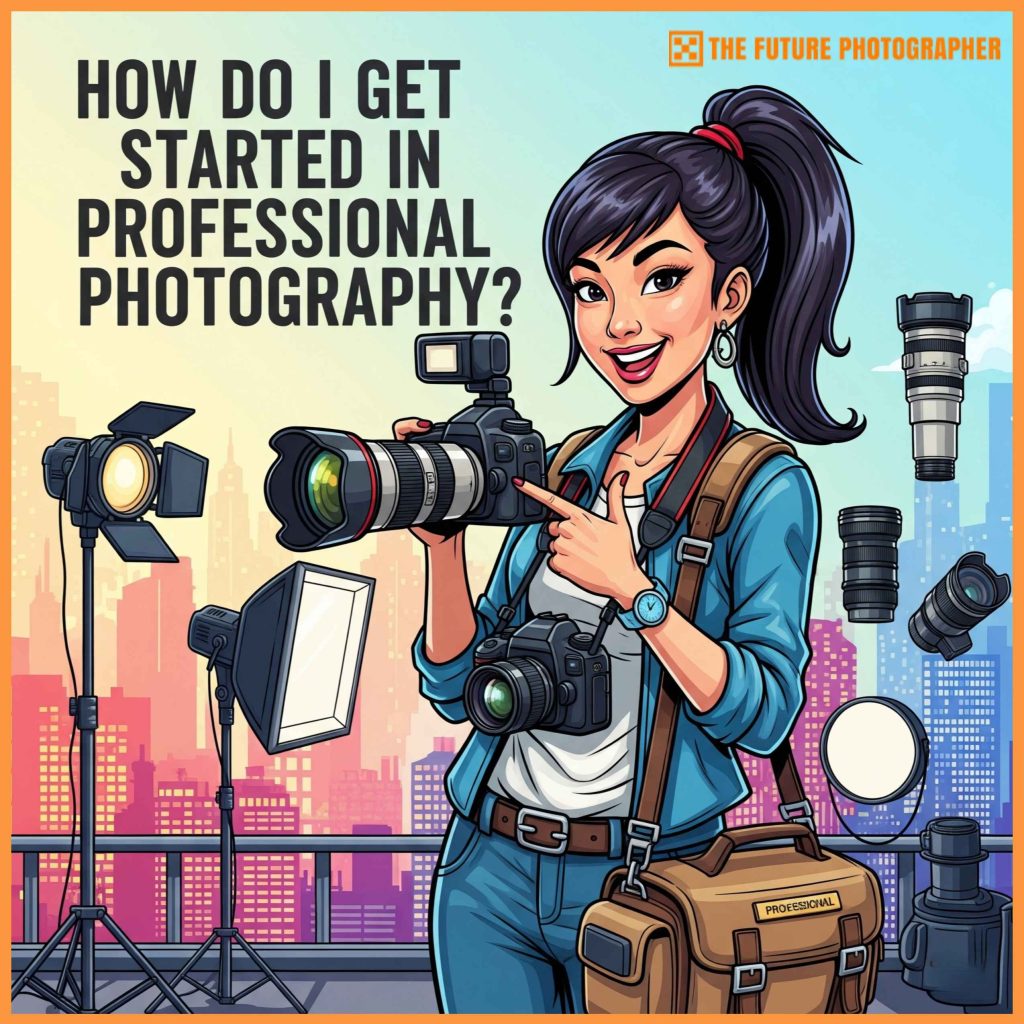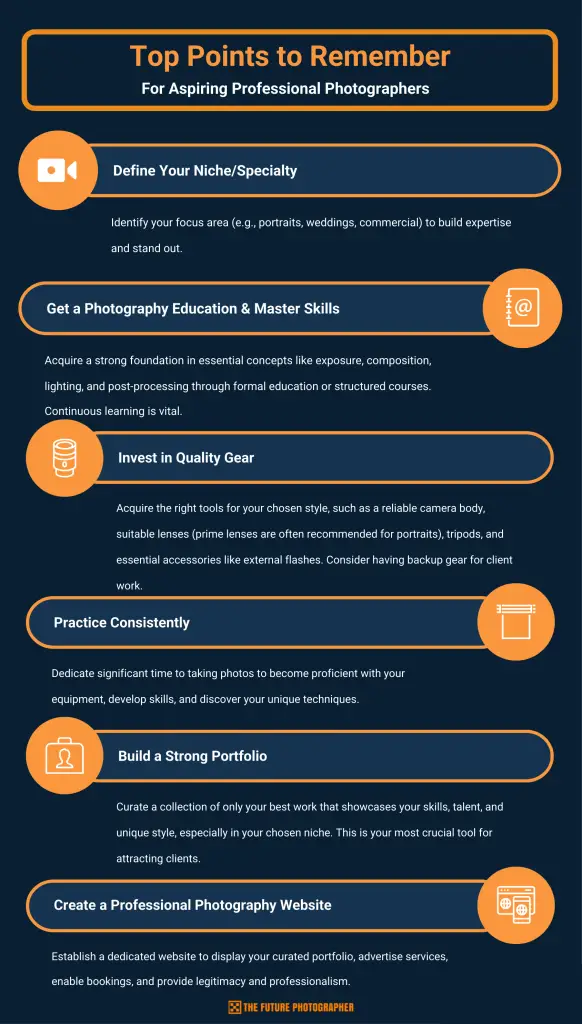
- Introduction
- Defining Your Unique Vision
- Finding Your Niche and Building Expertise
- Investing in Photography Education
- Mastering Core Photography Skills
- Strategic Gear Investment
- The Power of Practice and Portfolio Building
- Establishing an Online Presence
- Leveraging Social Media and Marketing
- Understanding the Business Side
- Cultivating Client Relationships and Networking
- Workflow Efficiency and Continuous Growth
- A Fulfilling Career Awaits
Introduction
Embarking on a career in professional photography is a truly exciting and rewarding journey. It offers a unique blend of creativity and flexibility, allowing you to express your artistic talents and pursue your passion. While the technological advancements of digital cameras have made photography more accessible than ever, succeeding as a professional in this incredibly competitive field requires far more than just taking good pictures. Indeed, it demands dedication, continuous learning, creative exploration, and astute business acumen. This comprehensive guide will illuminate the path, drawing on expert advice to help you transform your love for photography into a thriving profession.
Defining Your Unique Vision
The first and arguably most crucial step on your photographic adventure is to cultivate your passion and discover your unique style. Ask yourself why you want to be a professional photographer and what truly motivates you. Consider what value you can offer to clients. This initial self-reflection is paramount. It helps you clarify your purpose.
Professional photographers often specialize in specific environments or subjects. Therefore, it is highly recommended to explore multiple types of photography early on. Experiment with diverse subjects and styles, ranging from portraits to landscapes, macro shots to panoramic views. This broad exploration extends your knowledge and skills significantly. Furthermore, it can open doors to various freelance opportunities.

Finding Your Niche and Building Expertise
As you explore, you will begin to identify what excites you most. Establishing a specific niche is a pivotal step. It allows you to develop a personal style and build a brand that stands out. Consider your favorite subjects and preferred working environments. Do you enjoy working indoors or outdoors? Are you passionate about events, people, animals, or landscapes?
Some common types of photographers include wildlife, news, event, wedding, and family. For instance, if you love people, you might specialize in weddings, portraiture, or newborns. Conversely, if you prefer fast-paced environments, press photography could be your calling. A deeper skill set in a particular field often brings more value than a wider, more general one. Ultimately, your niche should balance what you love with market needs.
Investing in Photography Education
While becoming a photographer can certainly be self-taught, formal education provides a strong foundation. It introduces you to essential concepts, techniques, and the history of photography. Courses can cover composition, lighting, and post-processing, among other vital skills. A degree, however, is not a necessity for success.
Many experienced photographers, like Daniela Dawson, an NYIP Student Mentor, have worked globally in various photographic fields. The New York Institute of Photography (NYIP) is cited as a good choice for learning at your own pace with access to one-on-one mentorship. Options for education include photography programs, local schools, online courses, workshops, or even university degrees like a Bachelor of Fine Arts (BFA) or Master of Fine Arts (MFA) with a photography concentration. These programs can enhance your resume and help you build a quality portfolio. They also connect you with fellow aspiring photographers, fostering a creative community.

Mastering Core Photography Skills
Regardless of your chosen learning path, continuously learning and mastering basic skills is paramount. Margaret, a social media manager at S’well, emphasizes that effort is key, even if initial photos aren’t perfect. Essential skills include understanding exposure (aperture, shutter speed, ISO), mastering lenses, and controlling lighting (natural, studio, flash). Proper focusing, framing, and composition are also critical. Learning how to pose models, families, and couples is crucial for portrait photographers.
Furthermore, dedicate significant time to developing your editing skills. Post-processing software like Lightroom and Photoshop are industry standards. These tools are essential for transforming images from good to outstanding and for expressing your personal style. There are also free alternatives to paid software, such as Skylum’s Luminar 4, which offers advanced editing features. Understanding the technical differences between camera types, sensor sizes, and raw images is also vital for a professional workflow.
Strategic Gear Investment
While the myth that expensive gear makes a great photographer is untrue, investing in quality photography gear is a significant step. It’s about having the right tools for your preferred style and niche, not necessarily the most expensive equipment. Start with a reliable camera body and lenses suitable for your genre. For portraiture, prime lenses are highly recommended for achieving professional-looking bokeh. A mid-range zoom and a prime lens (like a 35mm or 50mm) are good starting points.
Don’t forget other essentials like tripods, filters, external flashes, and memory cards. For client work, having backup gear is always a wise decision. It prevents potential disasters. You can also rent expensive equipment that you don’t need regularly. This strategy allows you to test gear before committing to a purchase. Ultimately, gear quality often outweighs quantity.

The Power of Practice and Portfolio Building
Practice is one of the most important steps in becoming a professional photographer. It allows you to become comfortable with your equipment and develop your skills. You can determine the techniques you enjoy most through consistent shooting. Charlie, a photographer with years of experience, emphasizes that practice is fun and helps build your portfolio.
Take your camera everywhere. Treat every outing as an opportunity to grow your portfolio. Shoot for friends and family for free when starting out. This helps you gain experience and build a strong portfolio. Remember to be strategic when shooting for free. It should be done to acquire stunning images that prove your capabilities to potential clients.
Your portfolio is your calling card. It is the most crucial tool to showcase your best work and win new clients. Curate it carefully, highlighting your style and strengths. Only include your best work, not all your work. It should focus on your niche and the type of work you want to be hired for. Building a solid portfolio is a key to a successful career.
Establishing an Online Presence
Once your portfolio is strong, creating a professional photography website is crucial. A website conveys professionalism and provides a robust foundation for your business. It allows for Search Engine Optimization (SEO), helping potential clients find you online. Furthermore, a website can feature client galleries, booking systems, and even options to sell your photos directly.
Platforms like Wix and Pixpa are highly recommended website builders for photographers. They offer flexible and intuitive templates that are easy to manage. While social media is important, it is not enough on its own. A website gives you a dedicated space to showcase your complete body of work. It demonstrates you are serious about your craft.

Leveraging Social Media and Marketing
Social media is an indispensable tool for marketing your services. Use platforms like Instagram, TikTok, YouTube, LinkedIn, and Pinterest to display your work and connect with clients. Post consistently and create a lot of engaging content. Give value to your target audience. For instance, a wedding photographer could share tips for couples planning their big day.
Beyond social media, there are numerous marketing strategies to employ. Participate in photography contests to gain exposure. Attend local trade exhibitions and network at events. Consider forming collaborations with other businesses or brands. Developing a memorable brand and consistent visual identity will help you stand out.
Understanding the Business Side
Most professional photographers eventually become business owners. This necessitates strong business acumen. Creating a business plan is vital. It helps you define the services you offer and how to price them effectively. Understanding your costs and profit margins is critical for setting fair prices. Research local competitors, but be confident in your worth without undercutting others.
It’s also essential to track your income and expenses. Prepare templates for quotes, invoices, and contracts. This ensures you get paid as agreed and protects you legally. Consider forming a legal entity like an LLC or S corporation for protection and potential tax advantages as your business grows. Having proper insurance for your equipment is also a wise move.

Cultivating Client Relationships and Networking
Excellent customer service is paramount for retaining clients and generating referrals. Be professional, responsive, and punctual. Deliver high-quality work that exceeds expectations. Margaret from S’well, for example, went the extra mile by creating a custom portfolio of her work to land her job, demonstrating passion and effort. Going the extra mile makes clients feel valued, leading to repeat business and enthusiastic referrals.
Networking and connecting with fellow photographers and industry professionals is key. Attend photography events, workshops, and exhibitions. Join online and local photography communities and forums. Offering to assist or second shoot for experienced photographers can provide invaluable hands-on learning and portfolio building opportunities.
Building relationships with peers, rather than seeing them as competitors, can lead to collaborations and referrals. People buy from people, so making a positive impact and being remembered is crucial for referrals. Developing your “elevator pitch” to succinctly share what you do can be very helpful. Joining professional photographer associations also provides networking opportunities and a support network.
Workflow Efficiency and Continuous Growth
Refining your workflow is essential for efficiency and meeting deadlines. This includes small but important tasks like charging batteries and formatting memory cards before a shoot. Becoming proficient in post-production and learning how to batch edit photos can save significant time. Consistently backing up your projects and maintaining an organized file system is crucial for client requests and data safety.
Moreover, the journey of becoming a professional photographer is one of continuous learning and growth. You should never stop seeking ways to expand your knowledge and improve your services. Stay updated on industry trends, new equipment, and emerging technologies through blogs, magazines, and online tutorials. Challenge your skills with new projects, even outside your niche.
Join professional associations and actively participate in their activities, such as monthly competitions or challenges. Learning from other photographers, perhaps through online forums or local groups, can provide insights into pricing, techniques, and tricks. The goal is to always refine your photography eye. Keep your passion for photography alive. It is the sure-fire recipe for long-term success.

A Fulfilling Career Awaits
The path to becoming a professional photographer is indeed an exciting and rewarding one. It allows you to meet many interesting people and pursue your creative purpose. While success doesn’t happen overnight, with the right blend of passion, education, dedication, appropriate gear, honed skills, a strong portfolio, and robust business acumen, you are well on your way to making your mark.
You can achieve your true potential. Remember that income varies widely based on specialization and experience. However, it is very possible to earn a good income. The job outlook for photographers is expected to grow faster than the average for all occupations. Embrace the journey, and enjoy the captivating world of professional photography.

